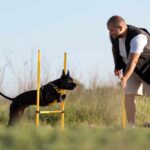Dog training is an essential part of responsible pet ownership. It’s not just about teaching tricks—it’s about helping your dog become a well-mannered, confident, and safe companion. Whether you’re working with a puppy or an older dog, proper training lays the foundation for a lifelong bond between you and your furry friend. From basic obedience to social skills and behavioral management, here’s what dog training typically involves:
Basic Obedience Commands
One of the first things dogs learn during training are basic obedience commands such as sit, stay, down, come, and leave it. These commands are vital for day-to-day management and communication. Teaching your dog to “sit” helps calm them in busy settings, while “stay” keeps them in place and out of harm’s way.
The “come” or recall command is particularly important for safety, ensuring your dog returns to you when called, even if off-leash. Commands like “leave it” or “drop it” can prevent them from grabbing harmful objects. These basics serve as the building blocks for more advanced training and improve your dog’s responsiveness.
Socialization Skills
A well-socialized dog is confident and less reactive in unfamiliar situations. Training programs often include socialization exercises, especially during puppyhood. This includes controlled introductions to new people, other dogs, children, and everyday environments like parks, sidewalks, and busy streets. Exposure to various sights, sounds, and experiences helps reduce fear and anxiety, which can lead to aggression or nervous behavior if not addressed early. Socialization is a critical part of helping dogs feel at ease in a variety of settings.
Leash Training and Walking Etiquette
Walking a dog should be enjoyable, not stressful. Loose leash walking training is a major focus in early dog training, teaching dogs to walk calmly without pulling or lunging. Commands like “heel” help your dog stay by your side, and learning to ignore distractions such as other dogs or food on the ground helps keep everyone safe. With proper leash manners, your dog can enjoy outdoor adventures while remaining under control and focused on you.
House Training and Manners
House training is essential for puppies and newly adopted dogs. This involves teaching where and when it’s appropriate to relieve themselves, often through a routine and consistent schedule. Crate training may also be used to create a safe, comfortable space that aids in potty training and prevents destructive behavior when you’re away.
Good manners also include not jumping on people, not begging at the table, and knowing what is acceptable to chew on. These lessons make a dog more welcome in any environment and prevent annoying or unsafe habits from forming.
Behavioral Correction and Impulse Control
Dog training also addresses unwanted behaviors such as excessive barking, chewing, digging, and separation anxiety. Trainers work with dogs using positive reinforcement and redirection techniques to replace bad behaviors with good ones. Impulse control is a key part of this process.
Dogs learn to wait patiently at doors, resist chasing after distractions, and only take food or toys when permitted. This teaches self-discipline, helping dogs make better choices and remain calm in stimulating environments.
Advanced Training and Tricks
Once your dog has mastered the basics, training can move into more advanced territory. This might include learning to respond to hand signals, performing tricks like roll over, spin, or shake, or even participating in dog sports such as agility or scent detection. These activities are not just fun—they also provide mental and physical stimulation, which helps reduce boredom and problem behaviors. Advanced training strengthens your dog’s focus, responsiveness, and deepens the bond between dog and owner.
Emergency Commands and Safety
Safety-focused commands are crucial, especially in situations that require immediate action. Teaching your dog an emergency recall (a strong “come” that they respond to without hesitation) can save their life if they’re headed toward danger. Commands like “stop,” “off,” and “leave it” are also essential for preventing accidents or injuries. These skills give you peace of mind, knowing your dog will respond reliably even in high-stress or high-risk moments.
Bonding and Communication
Training is more than behavior—it’s about building a lasting relationship. When you train your dog, you’re developing a language that helps you communicate clearly. Dogs thrive on structure and positive reinforcement.
Training provides both, strengthening trust and improving your ability to guide and understand your pet. Whether it’s a five-minute practice session or learning a new trick, each interaction enhances your connection and helps your dog feel secure and valued. If you want to provide the best training to your dog, you should consider hiring the best trainer. For instance, trainer at K9 wellness academy offers the best dog training Orange County.
Final Thoughts
Dog training is a holistic process that goes far beyond teaching commands. It shapes your dog’s behavior, helps prevent issues, and builds a strong foundation for lifelong companionship. From basic obedience and house manners to leash walking, social skills, and safety commands, every lesson contributes to a well-rounded, confident, and happy dog.
Regardless of breed or age, any dog can benefit from consistent, patient training—and so can their humans. When done with care and understanding, training becomes a rewarding journey for both of you.

